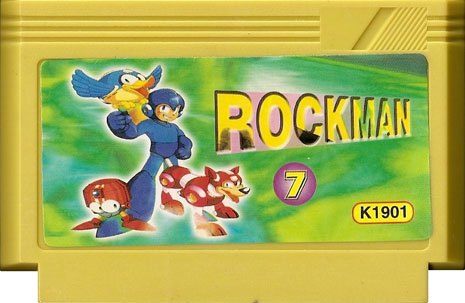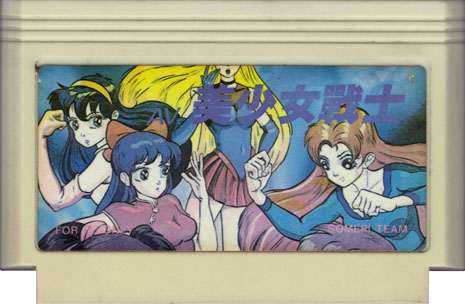Article
Sometime you come across a pirate cart and you just aren’t sure if it’s worth the money. You take a careful look at the label, seeing what names are there. You ask the seller to list the games on the cartridge if it’s a multicart. If the seller has a list he got from actually booting up each game on the cart, you’re safe. But often times all you know is what the front and back labels say. And when that happens, the games you actually get can be utterly disappointing. It happens countless times: the label says “WarioLand” but the game on the cart is actually Super Mario Bros.
Pirate developers and manufacturers are clever. They quickly came to understand the importance of flashy labels. And, unfortunately, they’re very willing to misrepresent what games are actually on the cart.
Lesson #1: Label Art Lies
Take a close look at the Rockman 7 cart to the right. Notice anything?
The first thing you might notice is that the label’s kind of flashy, with that green and yellow background. The fonts are nicely shaped. It’s got Rockman there with his friends. The makers of this cart obviously weren’t working with rudimentary printing equipment or an old software program. Notice anything else about this cart? Well, what’s with that “7” on the label? There wasn’t a Rockman 7 for Famicom! You might be wondering if it’s a very rare Rockman 7 for the Famicom. Likely not. The label maker for this pirate just got creative, probably thinking a Rockman 7 would sell better than a Rockman 1, 2, 3, 4, 5 or 6. And guess what? It works. It did and still does sell better, because most gamers think they’ve found a gem when all they’re really getting is a Rockman 7 label on a Rockman 6 cart.
Lesson #2: Numbers Lie
Take a look at the next cart. It says “9999999 in 1.” Sounds pretty nice, nearly 10 million games on one cart. Think again. While it’s possible to pack maybe 100 or more different games onto a Famicom game board, it doesn’t happen often. What’s more likely is that the pirate maker will put about 10 to 15 different games on a cart and then repeat those games for the remainder of the 9,999,999 titles on the menu screen.
Some multicart developers make Famiclones with 76,000 preloaded games on them. They really have only about 50 unique games, and those games are repeated again and again, using variations of the original game, such as “Galaxian HTS” and “Galaxian FWT.”
Sometime, however, you might get lucky. There are two ways to get lucky. The first, of course, is to actually get a pirate multicart that has more than 50 unique games on it. Some multicarts have been known to have up to 120 different games. Those are hard to come by. The second way to get lucky is to find a multicart where the pirate makers have juiced up some of the repeats. In other words, not only do you get the original Super Mario Bros. but you also get the strange hack Fancy Mario and Crazy Mario, or some other hack.
Lesson #3: Almost No Quality Control
Look at the next cart: Batman.
There are two types of pirate carts: PROM (or EPROM) and globtops. PROMs are the large chips you’re used to seeing on licensed boards. They’re sturdy and seemingly incapable of easy data corruption. Globtops are tiny chips covered by a glob of hardened black goo. If you’re into buying pirates, you should avoid carts with globtop boards, because they’re more likely to die quicker. It won’t be easy to tell what board you’re getting by looking at the outside of the cart; you’ll often need to see the board inside or feel the weight of the cart, since globtops are light and PROMs are heavier.
Look at that Batman cart again and pay attention to the color of the plastic. It’s yellow, and most often you’ll find that yellow, tan and gray plastic carts have globtop boards inside.
But globtops shouldn’t be your only quality-control concern. Sometimes pirate manufacturers were so bad at their jobs, they stuck the wrong board into a cart. So, your label might say one thing, but the board might have an entirely different game on it. Sachen is one of the worst companies to do this. You buy a cart with a certain label — let’s say Master Chu and the Drunkard Hu — but then you pop in the game to play it and it’s Pyramid. It’s just terrible. This happens with multicarts, too. Some multicarts will have a label showing the games on it, even listing the names, and the board will have completely different games.
Lesson #4: Pirates Aren’t Worth Much
I know. I know. You’ve been on eBay before and watched helplessly as you were outbid by lunatic bidders on that neat looking pirate cart. It’s happens. People go crazy for pirates. With the good pirates so hard to come by, it’s really a gamble if you’re paying high prices and you have no idea what games are actually on the cart.
Pirate carts with only one game on them are worth next to nothing. I wouldn’t pay over $5 for one of those and probably closer to $3. Of course, it always depends on the game on the cart. If the game is, say, Recca: Summer Carnival ’92, it’ll obviously go for more, since it’s a rarer game than, say, Snow Bros. — the next cart to the right, — which you can find pirated almost anywhere you look.
These are the single cart (sometimes these games are found on multicarts) to look out for. They’re definitely the hardest to come by:
Aladdin
AV Beautiful Girl Fighting
Boogerman
Dance Dance Revolution
Donkey Kong Country
Earthworm Jim
Fatal Fury
Golden Axe
Kart Fighter
The Lion King
Master Fighter
Mortal Kombat
Pocohantas
Power Rangers
Somari: The Adventurer
Sonic the Hedgehog
Street Fighter
Super Mario World
Tekken
Time Diver Avenger
Windows 2000
All of those games were never made for the Famicom. The developers hacked other console’s games, including 16-bit Super Famicom games, and tailored them to work on the 8-bit Famicom. They’re exceptionally rare, for the most part; some of them have hacks by similar titles. There are more 16-bit hacks out there, or other unique hacks, not in that short list. For instance, there’s a version of Street Fighter where you get to fight as the Playboy Bunny, and there’s a game where the Teletubbies are hacked in place of Mario. You just never know what you’ll find.
Some pirates were made for the Famicom Disk System and then ported by a pirate maker to cart. Those are hard to find, too, but you can find them if you try. For example, Doki Doki Panic was ported to cart. Others, like Recca, were made as carts but had a limited release, so finding a pirated version of it is like finding Famicom pirate gold.
Few pirated carts come with a manual. But more often you’ll see one with a box. Usually the companies putting out pirated cartridges have a uniform box for all their games, regardless of the game or games on the cartridge, maybe with a little plastic window showing the name of the game on the cart’s label. Some pirated games come with their very own box, which are hard to find, and make the games worth that much more.
Lesson #5: Pirates Are Mass Produced
Finally, we have the last cart to the right: AV Beautiful Girl Fighting. You might also recall that it’s also in the special cart list above. Well, even though it’s a cart to watch out for, that doesn’t really mean it wasn’t mass produced. Pirate carts (and even their boxes) were, in fact, mass produced, though not in as high a number as legit carts. Don’t forget that: Pirate carts were mass produced. So, you don’t have to go crazy bidding on one, thinking you’ll never see it again. You will, with some patience.
Happy hunting! And let FW know if you find anything interesting.




